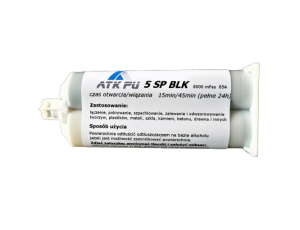Sealing and filling adhesives
Sealing and sealing adhesives can be divided into 3-4 categories of the most commonly used cases. Below we present how to easily select the appropriate products for sealing various surfaces. 1. Electronic fillers to prevent the ingress of moisture, water and other chemicals, increasing the IP standard. The basic version is Kemispox Z in transparent or black color if we want to visually protect the systems. It is an epoxy based version for mixing by hand or using a dispenser, very fluid - it pours itself. Sometimes, however, the required layer has to be slightly elastic, then choose an adhesive, polyurethane sealant PU 5 or PU9.2. Waterproofing concrete - construction surfaces - horizontal floors in communication routes inside and outside companies, balcony sealants, roof attics between tiles and concrete, brick walls and road expansion joints. We do it with the liquid polymer ATK 812 SL sealant. It is not a polyurethane, so it can be used indoors, and most importantly, the solvent does not evaporate over the years because it simply does not exist. For vertical and sloping and even ceiling waterproofing, choose the standard version ATK 812. For absorbent surfaces, use a primer such as P200.3. Sealing and bonding vapor barriers made of thin and thick films. Even 2 mm, most often made of PE - PEHD, we use a product in the form of a flexible, still sticky HYLKOL cord. Importantly, it is a modified product, so it does not harden over time, even when exposed to the sun and weather conditions (like other similar products that fall off after 1-2 years). We also use it for sealing between the vapor barrier and timber-rafters, plasterboards, concrete, bricks and silks. With loose dusting elements, remember to prime the surface only. 4. Elements made of plastic, metal, glass and ceramics are sealed with a liquid gasket that can be disassembled in the future - we are talking about all flat surfaces that can be folded together, such as oil sumps, industrial seals, etc. Leaking pipes and tanks can be sealed with the Med21 set if the elements are made of copper, Fe21 for steel and Al21 for aluminum. 6. Universal sealant for various surfaces, from wood to PP plastic, is ATK 812. Adhesive in a dense form, flexible like rubber. Resistant to water, but also to petrol, greases and oils. How to check if the product I bought will be resistant to the chemicals it provides? You perform a trial test on the material that you will seal. You create 3-5 of such samples. After full hardening, two samples are left for comparison; You put 1-2 in the liquid to which it is to be resistant and leave it for 7-14 days, and you freeze 1-2 samples if in such conditions the product is also to work for 7-14 days. After this time, you compare to the starting samples. Pay attention to whether and how the stamina has dropped. If it is in the range of 10-20%, you can use it, if more means that either the product is not suitable. If it becomes soft, it can often come off the surface, then you should consider if something is happening to the material itself and you may need to use, for example, an etcher or primer.




.jpg)







